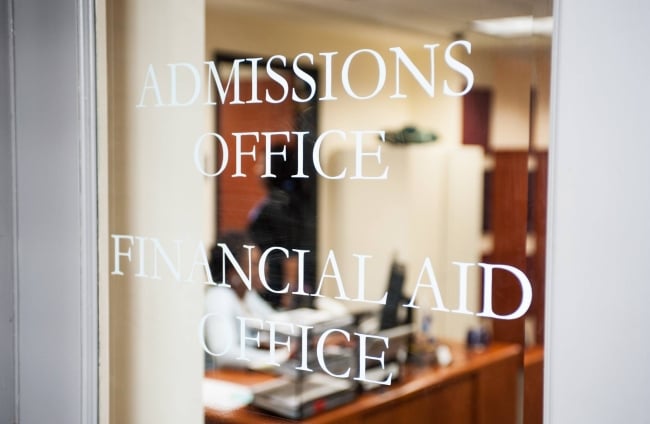You have /5 articles left.
Sign up for a free account or log in.

George Washington University Law School's admissions office.
George Washington University Law School
Law schools across the country are fighting for transfer students in a testy cat and mouse game that involves some questionable practices.
In areas with multiple law schools -- like Washington, Phoenix and northern Florida -- the transfer market has lately exposed the contentious underbelly of legal education. The transfer market has become particularly active in recent years as overall law school enrollment has fallen dramatically.
Critics say law schools farther up the rankings chain are enrolling students whose Law School Admission Test scores made them undesirable to enroll as first-year students. Law schools generally do not give transfer students the sort of competitive scholarship discounts they dangle in front of first-year students, making transfers a potentially lucrative source of revenue.
Schools that lose dozens of students each year to other law schools accuse their competitors of poaching to boost enrollment and get around college rankings.
Schools that pick up those same students say the schools’ students are obviously not satisfied, or else so many would not head for the exit.
Some transfer students even say they have to cut through a variety of questionable practices designed to make it harder for them to leave one school for another.
Last year, about 2,200 law students transferred, according to reports law schools file with their accreditor, the American Bar Association. The percentage of law students transferring has risen in recent years to about 5.5 percent last year, according to a recent analysis by Jerome M. Organ, a professor at University of St. Thomas School of Law who studies the legal market and did an analysis that Inside Higher Ed relied on and partially replicated for this article.
Most students who transfer do so after finishing their first full year of law school, though some transfer after just their first semester.
Georgetown University Law Center, one of the top law schools in the country as judged by U.S. News and World Report rankings, took 113 transfer students last year -- more than any other law school in the country. About a sixth of Georgetown’s second-year law school class is students who were not initially admitted to Georgetown.
Andy Cornblatt, Georgetown law school's dean of admissions, said the school is not doing anything to lure students away from other schools. “We’re doing nothing, we’re simply giving them the opportunity to do what they want to do,” he said.
Once transfer students come to Georgetown, he said, they perform as well as students who spent all three years on campus.
Last year was the first time the ABA required schools to give detailed reports on the students they take from elsewhere. Before, law schools had to report how many transfer students they gained and lost. Now, schools that take more than five transfers have to report where the students came from.
The reports confirm what many legal-education observers already knew, but now allow everyone to see just what is happening in greater detail: top-ranked schools are taking students from lower-ranked schools.
The Washington, Phoenix and northern Florida area transfer markets are particularly hot, and deans on the losing end of the stick are beginning to get hot under the collar.
In Washington, the clearest loser is American University's Washington College of Law. Last year, it lost 100 of the 473 students it had enrolled a year before to other schools -- more departing transfer students than any other law school in the country.
American lost 13 of those students to Georgetown and 55 to George Washington University. Using the imprecise measuring stick of U.S. News law school rankings, Georgetown and George Washington are both top 20 schools. American is ranked 72nd. Yet a significant number of Georgetown's and even more of George Washington’s students were originally American students. In 2013, the median LSAT score at Georgetown was 168; at George Washington, 165; at American, 157.
American’s losses prompted its associate dean for academic affairs, Anthony Varona, to call George Washington “downright predatory” in an online post.
He said George Washington was pulling a “bait and switch” on its students. When U.S. News ranks law schools, it looks at the quality of incoming students based on LSAT scores and undergraduate grades. But its rankings look only at first-year students, not transfers. George Washington has a top ranking even though its class includes a lot of American students.
In a statement, American said rankings have led to "other practices in legal education that are not transparent or desirable, such as the elimination of need-based scholarships and law schools increasing the size of the second-year class while reducing first-year enrollment."
George Washington said it does not "actively solicit" for any transfer student.
“The students we accept by transfer make great contributions to the law school, and we are delighted to welcome them to our campus,” Sophia Sim, George Washington Law School's associate dean for admissions and financial aid, said in a statement.
Little data exist on what transfer students pay. Schools have traditionally not offered merit scholarships to transfer students. That means schools bring in more revenue per head from transfer students than from first-year students, who are often offered scholarships.
One 2011 study found evidence that transfer students as a group pay more after they transfer than before.
Cornblatt said it would violate antitrust laws and be "paternalistic to the extreme" to try to curb transfers.
“These are not elementary school kids, these are adults who are in the middle of or finished their first year of law school,” he said.
Officials at schools that admit lots of transfer students point out that the LSAT score is supposed to predict how well a student will do in their first year and nothing more. In this view, if students do well in their first year at one school, it doesn’t matter what the students' LSAT scores were -- they’ve proven they can do well.
“The LSAT is a good predictor of first-year performance, but it’s nowhere near as good a predictor as first-year performance,” said Douglas Sylvester, the dean of Arizona State University’s Sandra Day O'Connor College of Law.
Arizona State accepted 66 transfer students last year, the second most in the country, behind Georgetown. Nearly a third of ASU’s second-year students are now transfer students. Forty-four of those transfers came from Arizona Summit Law School.
Arizona Summit is a for-profit law school that admits first-year law students with some of the lowest LSAT scores and grades in the country. Then those students go to ASU, which is 31 on the U.S. News list. To put it bluntly: some of the most qualified first-year students routinely admitted to Arizona Summit are significantly less qualified on paper than the least-qualified first-year students ever admitted to ASU. That’s according to a look at records from the ABA, which only makes law schools report first-year student qualifications in quartiles, a demarcation that does not allow entirely precise analysis. In 2013, the bottom quarter of ASU students had a 158 on the LSAT or below; while the top quarter of students at Arizona Summit scored a 148 or above.
Arizona Summit Dean Shirley Mays said she wondered if Arizona State would take so many Arizona Summit students if the students’ LSAT scores counted against ASU’s U.S. News ranking.
“I do believe it to be poaching,” Mays said of ASU, “and I do wonder if the ranking system were changed so that the LSAT scores of transfer students were included whether or not the poaching of students from the lower-tiered schools would continue.”
Sylvester, the dean of ASU’s law school, said students leave Arizona Summit because ASU charges less, has better employment outcomes and a better bar passage rate. Without passing the bar, students cannot become practicing lawyers. For instance, the sticker price for ASU is $27,000 for Arizona residents and $42,000 for nonresidents, while Arizona Summit students all face a sticker price of $43,000.
"Give your students reasons to stay and we wouldn’t be able to take them,” Sylvester said.
Some students and former professors alleged Arizona Summit does try to get students to stay, by manipulating students, professors and the curriculum.
Two former professors, a married couple, are suing Arizona Summit for firing them. In the lawsuit, the professors said they were forced out for opposing “changes that would reduce students’ abilities to transfer" to other schools. Specifically, they accuse the school of reordering class offerings "so that competing law schools would not accept students requesting transfer because mandatory courses for transfer would not be included in the first-year curriculum."
Mays said the sheer number of transfers Arizona Summit continues to lose suggests the professors’ allegations are false.
“Since the adoption of our new curriculum, it has not had any negative impact on our students’ ability to transfer, because that was not the intent of the new curriculum,” Mays said.
Former Arizona Summit students are not so sure, though.
John Webster, who left Arizona Summit last year for ASU, said the school’s practices seemed focused on keeping students from leaving. At ASU, Webster is the transfer student representative, an elected position in the school’s student government.
“It became one of their main focuses -- just to maintain the student body they have,” he said.
Arizona Summit students have to meet with a dean at Arizona Summit before they transfer and before they can get their transcripts.
“It’s an awkward conversation that could be used as a deterrent,” he said.
Webster said the new curriculum could also throw up obstacles for would-be transfer students. Arizona Summit, in a dramatic shift from most other law schools and the history of legal education, has combined some traditional first-year classes. For instance, civil procedure and torts, which used to be two separate three-credit courses, are now one five-credit course.
Webster said this meant there were fewer courses each semester and that made it harder for students to have a good grade point average because there were fewer chances to mess up.
“Your G.P.A. would be destroyed by a C or a couple B’s,” he said. With a poor G.P.A., a student could not leave.
Webster's account was corroborated by several other former Arizona Summit students, although not all of them said Arizona Summit’s practices were that much of a hurdle. The students were referred to this reporter by Arizona State.
Similar concerns have been raised about Florida Coastal School of Law, which, like Arizona Summit, is owned by the for-profit law school consortium InfiLaw. A transfer student from Florida Coastal who is now at Florida State University said some of the same practices were in place at Florida Coastal, particularly the requirement that students looking to transfer need to meet with a dean. The student, who was referred to a reporter by a Florida State official, is about to graduate and look for jobs and did not want to be quoted by name.
Florida Coastal’s interim dean, Chidi Ogene, said he thinks such meetings are standard practice and are intended to see how well the school is serving students. Sometimes, he said, students are looking to transfer when they don't have to. One student, the dean recalled, wanted to practice in Texas so was thinking about transferring to Texas. Ogene said the student could spend time studying at the Texas school as a visiting student without having to transfer away from Florida Coastal. The student stayed, the dean said.
Florida Coastal lost 9 students last year to FSU, which took 31 transfer students. Florida State's first-year class the year before was 170 students.
Schools like Arizona Summit and Florida Coastal lose transfer students but rarely gain them.
Ogene said he wonders what happens to his students after they leave. “From my perspective, I don’t want to lose them, and it’s not so much the lost revenue for want of a better; sometimes I wonder if the very things that we do are what encouraged them,” Ogene said.
It’s inarguable that FSU and ASU have better bar passage rates than Florida Coastal, Arizona Summit and some of the other schools they draw from. But part of the reason very well could be that the lower-tiered schools are losing their best students.
What the first school did, after all, is what made a lower-performing student eligible to transfer.
“That has to account for at least part of the student success here,” Arizona Summit's Mays said. “So it’s possible that had they gone directly into another school, they would not have been as successful, but it’s also possible that they would have been.”
Unfortunately, schools do not have to break down any performance data about their transfer students, except for their incoming G.P.A. from their first year of law school.
Organ, the professor at St. Thomas who studies the legal market, said there is no publicly available data to sort through how transfers fare compared to other students.
The academic qualifications gap between a first-year Florida Coastal student and a first-year Florida State student raises serious questions about how prepared a transferring Florida Coastal-type student can do at an FSU, Organ said.
“I’m not saying that student can’t survive at Florida State, but that’s a completely different pond you’re swimming,” he said.
Arizona State's dean voluntarily revealed bar passage and employment data for 2014 graduates: while all ASU students, transfers and nontransfers, had about an 89 percent bar passage rate, transfer students did not fare as well when they went looking for jobs. At ASU, 2014 transfer graduates had a 74 percent employment rate, while 84 percent of all graduates -- including transfers and nontransfers -- were employed.
Organ also worries about the effect on schools. Many top law schools take transfers. Harvard Law School took 33 transfers, Columbia Law School took 46, Berkeley Law took 55, including 18 from another school in the University of California System, Hastings College of the Law.
Harvard and Columbia, though, took no more than four students from one single competitor. Berkeley, George Washington, Georgetown and ASU took a dozen or more students from other schools that admit students with strikingly different qualifications.
For those schools, Organ said, it is hard to make the case they are taking the real cream of the crop.
Consider Georgetown, with its 113 transfer students.
“They’re not taking 100 students who are exactly like the 400 or 500 they have," Organ said, "and it’s not that they can’t perform, but they’re not the same as the 400 or 500 they welcomed in the first year.”




